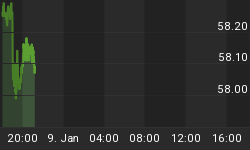The liquidity driven rally appears to be coming to an end. Although various economic indicators have become "less bad," we attribute the rally to, in large part, the huge liquidity injections by the Federal Reserve. As shown in the chart below, the adjusted monetary base exploded in the second half of 2008 in response to the Lehman Brothers collapse. Markets in Asia responded almost immediately while western markets lagged the injection by a few months. However, the monetary base has been stagnant for the past six months as the markets have continued to soar. Unfortunately for the bulls, a stable monetary base will not be sufficient fuel to power the markets much higher.
Adjusted Monetary Base Unchanged For 6 Months
Source: Federal Reserve Bank of St. Louis
The stable monetary supply coupled with the resurgence in Treasury bond demand further supports the likelihood that a correction in equities is ahead. When the Federal Reserve has printed enough money to make all asset prices rise, long-term Treasuries will fall but this has not yet happened. Meanwhile the Federal Reserve is focused on disseminating exit strategies, either thinking that the recovery is upon us or attempting to buy more time before markets become fearful of inflation.
30 Year Treasury Rates Have Stopped Rising
Source: Federal Reserve Bank of St. Louis
In March, when investors were bearish and scared, investors were bullish on the Dollar. Since then, the rallies in most asset classes, accompanied with the belief that the Federal Reserve has printed enough money to create an economic recovery, have encouraged bearish Dollar bets to an extreme. Such a one-sided bet has the potential to create a temporary short-squeeze. So should the bet against the Dollar prove untimely and the Dollar thus start to rise, commodity prices and equities will be pressured. Moreover, the latecomers that have helped drive equity prices higher during the last couple of months will instead be the ones who add pressure to the markets during the next correction.
Extreme U.S. Dollar Pessimism
Source: Elliott Wave Theorist, August 5, 2009
China's recent stock market correction is also troublesome given that China is supposedly the would-be leader in a global economic recovery. Although China's stock market has risen far more from the lows than the U.S. stock markets, its 22% decline in August does suggest some tightening in liquidity conditions.
Sharp Pullback in Chinese Equities
Along with the other indicators mentioned earlier, oil's inability to break out above the mid 70s on several occasions demonstrates that global liquidity has stopped increasing.
Oil Unchanged Since June
There are many indications that suggest that the Federal Reserve has yet to print enough money to offset the ongoing deleveraging. With the monetary base stabilized for many months it seems likely that asset markets will correct in the coming months. If and when asset prices start to fall, the Federal Reserve will, as always, increase its quantitative easing efforts to resuscitate the very markets it believes it has already fixed. Perhaps gold's recent surge suggests that market participants are starting to view this scenario as likely. Regardless, the Federal Reserve will ultimately succeed in getting all asset prices to rise by continuously printing money.
















